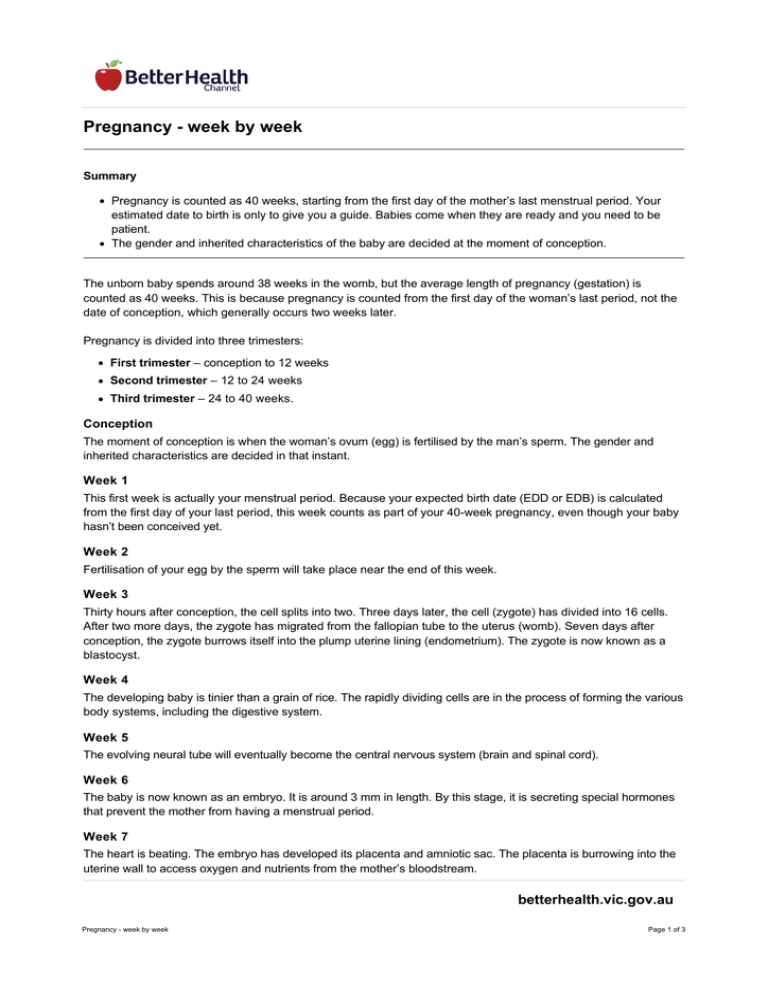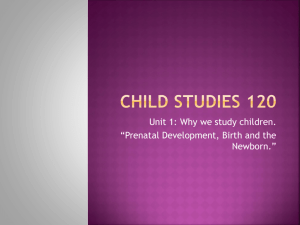Pregnancy - week by week
advertisement

Pregnancy - week by week Summary Pregnancy is counted as 40 weeks, starting from the first day of the mother’s last menstrual period. Your estimated date to birth is only to give you a guide. Babies come when they are ready and you need to be patient. The gender and inherited characteristics of the baby are decided at the moment of conception. The unborn baby spends around 38 weeks in the womb, but the average length of pregnancy (gestation) is counted as 40 weeks. This is because pregnancy is counted from the first day of the woman’s last period, not the date of conception, which generally occurs two weeks later. Pregnancy is divided into three trimesters: First trimester – conception to 12 weeks Second trimester – 12 to 24 weeks Third trimester – 24 to 40 weeks. Conception The moment of conception is when the woman’s ovum (egg) is fertilised by the man’s sperm. The gender and inherited characteristics are decided in that instant. Week 1 This first week is actually your menstrual period. Because your expected birth date (EDD or EDB) is calculated from the first day of your last period, this week counts as part of your 40-week pregnancy, even though your baby hasn’t been conceived yet. Week 2 Fertilisation of your egg by the sperm will take place near the end of this week. Week 3 Thirty hours after conception, the cell splits into two. Three days later, the cell (zygote) has divided into 16 cells. After two more days, the zygote has migrated from the fallopian tube to the uterus (womb). Seven days after conception, the zygote burrows itself into the plump uterine lining (endometrium). The zygote is now known as a blastocyst. Week 4 The developing baby is tinier than a grain of rice. The rapidly dividing cells are in the process of forming the various body systems, including the digestive system. Week 5 The evolving neural tube will eventually become the central nervous system (brain and spinal cord). Week 6 The baby is now known as an embryo. It is around 3 mm in length. By this stage, it is secreting special hormones that prevent the mother from having a menstrual period. Week 7 The heart is beating. The embryo has developed its placenta and amniotic sac. The placenta is burrowing into the uterine wall to access oxygen and nutrients from the mother’s bloodstream. betterhealth.vic.gov.au Pregnancy - week by week Page 1 of 3 Week 8 The embryo is now around 1.3 cm in length. The rapidly growing spinal cord looks like a tail. The head is disproportionately large. Week 9 The eyes, mouth and tongue are forming. The tiny muscles allow the embryo to start moving about. Blood cells are being made by the embryo’s liver. Week 10 The embryo is now known as a fetus and is about 2.5 cm in length. All of the bodily organs are formed. The hands and feet, which previously looked like nubs or paddles, are now evolving fingers and toes. The brain is active and has brain waves. Week 11 Teeth are budding inside the gums. The tiny heart is developing further. Week 12 The fingers and toes are recognisable, but still stuck together with webs of skin. The first trimester combined screening test (maternal blood test + ultrasound of baby) can be done around this time. This test checks for trisomy 18 (Edward syndrome) and trisomy 21 (Down syndrome). Week 13 The fetus can swim about quite vigorously. It is now more than 7 cm in length. Week 14 The eyelids are fused over the fully developed eyes. The baby can now mutely cry, since it has vocal cords. It may even start sucking its thumb. The fingers and toes are growing nails. Week 16 The fetus is around 14 cm in length. Eyelashes and eyebrows have appeared, and the tongue has tastebuds. The second trimester maternal serum screening will be offered at this time if the first trimester test was not done (see week 12). Week 18-20 An ultrasound will be offered. This fetal morphology scan is to check for structural abnormalities, position of placenta and multiple pregnancies. Interestingly, hiccoughs in the fetus can often be observed. Week 20 The fetus is around 21 cm in length. The ears are fully functioning and can hear muffled sounds from the outside world. The fingertips have prints. The genitals can now be distinguished with an ultrasound scan. Week 24 The fetus is around 33 cm in length. The fused eyelids now separate into upper and lower lids, enabling the baby to open and shut its eyes. The skin is covered in fine hair (lanugo) and protected by a layer of waxy secretion (vernix). The baby makes breathing movements with its lungs. Week 28 Your baby now weighs about 1 kg (1,000 g) or 2 lb 2oz (two pounds, two ounces) and measures about 25 cm (10 inches) from crown to rump. The crown-to-toe length is around 37 cm. The growing body has caught up with the large head and the baby now seems more in proportion. Week 32 The baby spends most of its time asleep. Its movements are strong and coordinated. It has probably assumed the ‘head down’ position by now, in preparation for birth. Week 36 betterhealth.vic.gov.au Pregnancy - week by week Page 2 of 3 The baby is around 46 cm in length. It has probably nestled its head into its mother’s pelvis, ready for birth. If it is born now, its chances for survival are excellent. Development of the lungs is rapid over the next few weeks. Week 40 The baby is around 51 cm in length and ready to be born. It is unknown exactly what causes the onset of labour. It is most likely a combination of physical, hormonal and emotional factors between the mother and baby. Where to get help Your doctor Obstetrician Midwife Things to remember Pregnancy is counted as 40 weeks, starting from the first day of the mother’s last menstrual period. Your estimated date to birth is only to give you a guide. Babies come when they are ready and you need to be patient. The gender and inherited characteristics of the baby are decided at the moment of conception. This page has been produced in consultation with and approved by: Department of Health and Human Services - CHI - HSR&I - Maternity & Newborn Clinical Network Content on this website is provided for education and information purposes only. Information about a therapy, service, product or treatment does not imply endorsement and is not intended to replace advice from your doctor or other registered health professional. Content has been prepared for Victorian residents and wider Australian audiences, and was accurate at the time of publication. Readers should note that, over time, currency and completeness of the information may change. All users are urged to always seek advice from a registered health care professional for diagnosis and answers to their medical questions. For the latest updates and more information, visit www.betterhealth.vic.gov.au Copyight © 1999/2016 State of Victoria. Reproduced from the Better Health Channel (www.betterhealth.vic.gov.au) at no cost with permission of the Victorian Minister for Health. Unauthorised reproduction and other uses comprised in the copyright are prohibited without permission. betterhealth.vic.gov.au Pregnancy - week by week Page 3 of 3



